The Three Noble Children of Japanese Mythology: Amaterasu, Tsukuyomi, and Susanoo

Contents
Have you ever heard a story where the Sun, the Moon, and the Sea are brothers and sisters?
In the old myths of Japan, this is exactly what happened. Long ago, the god Izanagi washed himself in a sacred river. And then, three powerful siblings were born—one to shine with light, one to guide the night, and one to rule the seas.
These children were given the sky, the night, and the ocean. But like many families, they also had moments of love, rivalry, and conflict.
Even today, their story shines in Japan’s shrines, festivals, and traditions. Come and discover the tale of the Three Noble Children—a story of light, family, and the natural world.
Who Are the Three Noble Children?
So who are these three siblings from Japan’s ancient myths?
They are:
- Amaterasu – the Sun Goddess, who brings light and warmth.
- Tsukuyomi – the Moon God, who watches over the night.
- Susanoo – the God of Storms and Seas, powerful and wild.
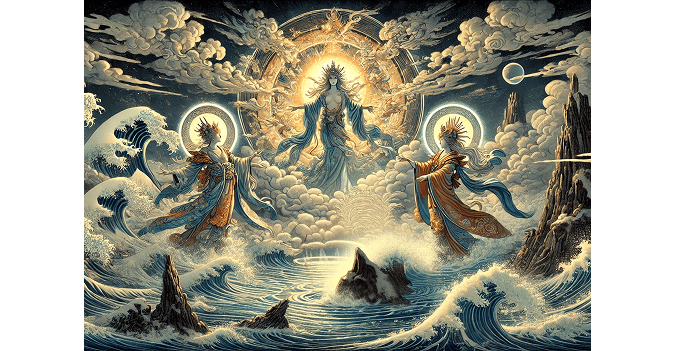
In Japanese mythology, they are called the Three Noble Children (Mihashira-no-Uzunomiko, 三貴子). The word noble means “precious” or “honored.”
When they were born, their father Izanagi said:
I have brought forth many children, but at last, I have gained three most noble ones.
Because of these words, they have been remembered as the Three Noble Children—the most treasured of all his divine children.
For the people of ancient Japan, this was not just a story but a reflection of daily life. The Sun, the Moon, and the Sea were so important that they could only be seen as sacred. They were life itself—light to grow food, time to guide the seasons, and water to give food and connection.
And so, the myths of their birth were told and retold, shaping how people understood the world around them.
The Birth of the Three Siblings
The story of their birth begins with Izanagi. After returning from Yomi—the land of the dead—Izanagi felt unclean and heavy with impurity. To wash this away, he performed a cleansing ritual called misogi, bathing in a sacred river to purify his body.
And then, something extraordinary happened.
- As he washed his left eye, a dazzling light appeared—Amaterasu, the Sun Goddess, was born.
- As he washed his right eye, a gentle glow shone forth—Tsukuyomi, the Moon God.
- Finally, as he washed his nose, a roaring spirit emerged—Susanoo, the God of Storms and Seas.
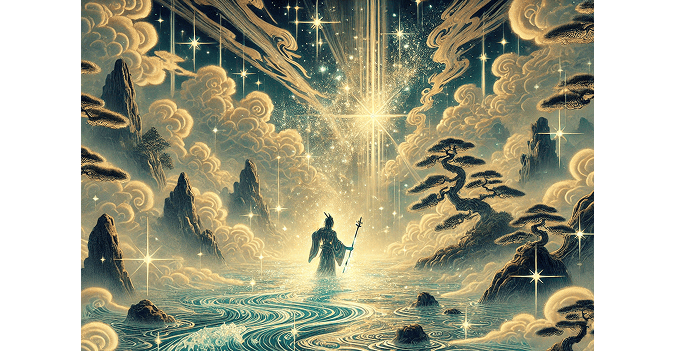
Izanagi was filled with joy. He had created many gods before, but these three were different. They shone brighter, felt closer, and carried the power of life itself.
At that moment, he gave each a role in the world:
- To Amaterasu, he entrusted the Sun and the heavens.
- To Tsukuyomi, he entrusted the night.
- To Susanoo, he entrusted the vast seas.
This was how light, time, and water came to be divided among the Three Noble Children—forever shaping the balance of nature and the lives of the people.
Note: In ancient Japan, daily life was guided by the lunar calendar, which used the phases of the moon to measure time and seasons.
Roles and Realms – Dividing the World
Imagine a world without the Sun, the Moon, or the Sea. No light to guide the day. No moon to mark the flow of time. No waters to give life or carry people from place to place. It would be a world of uncertainty and chaos.
The miracle of the Three Noble Children changed all of this. Their birth was not only a divine event—it marked the beginning of order in Japan’s world of myth.
From that moment, the rhythms of nature took shape:
- The Sun brought light, warmth, and the growth of crops.
- The Moon gave the passing of months and the flow of time.
- The Sea provided food, travel, and also the fearsome power of storms.
In this way, the three siblings came to represent balance itself. Day and night, sky and water, calm and storm—each had its place.
For the people of ancient Japan, this explained why the world felt stable and alive. It was shaped and guarded by the Three Noble Children. When we see their roles this way, it becomes clear just how precious and important these three deities truly were, don’t you feel the same?
Amaterasu – The Goddess Above All
The three siblings were born together, but they were not all equal. Among them, one stood above the rest—Amaterasu, the Sun Goddess. She was not only the goddess of light, but also the one Izanagi trusted the most. What made her so unique? Here are three signs of her special place.

1. A Gift Beyond the Sun
In fact, Izanagi gave Amaterasu something no one else received.
Along with the power of the sun, he placed around her neck a sacred necklace of shining jewels, said to hold part of his own spirit. Neither Tsukuyomi nor Susanoo received such a gift.
2. The Meaning of Her Name
Even her name shows her special honor: Amaterasu-Ōmikami. The word Ōmikami (大御神) means “Great Divinity” or “Supreme Goddess.” It is an exalted title used only for Amaterasu—no other deity in the Shinto pantheon carries such a name.
3. Born from the Left Eye
Her birth from Izanagi’s left eye also held deep meaning. In ancient Asian thought, the left side was the place of highest honor. So Amaterasu, the Sun Goddess, was born from the most auspicious seat in the cosmic order.
More Than Light
For the people of ancient Japan, the sun was already understood as the source of life. It gave warmth, allowed crops to grow, and marked the rhythm of the seasons. This shows how deeply they felt the greatness of the sun and how much gratitude they held toward it.
Amaterasu, as the Sun Goddess, came to represent far more than sunlight. She symbolized warmth, growth, leadership, and the guiding power of heaven itself. It is no wonder that Amaterasu is still worshiped today as the goddess above all others.
Bonds and Conflicts – The Drama Between Siblings
The Three Noble Children were siblings, and we might wish they could have lived in harmony.
But like many families, they were not always close, and their bonds were sometimes tested by rivalry and conflict. Each ruled a different realm—heaven, night, and sea—but their actions often touched one another’s worlds.
Amaterasu and Susanoo
Among the siblings, Amaterasu and Susanoo had the most troubled bond.
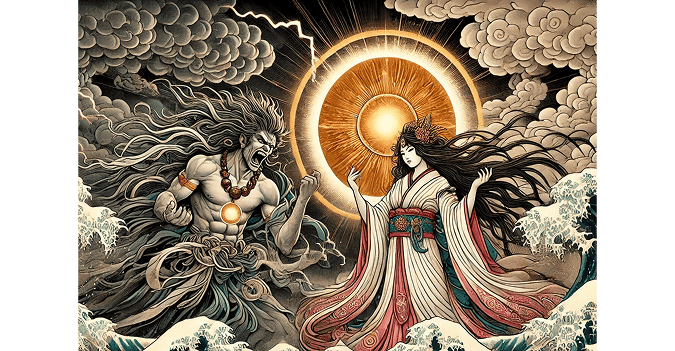
Susanoo, wild and reckless, often caused chaos even in the heavenly realm. His actions led to the famous story of the Heavenly Rock Cave (Amano-Iwato), where Amaterasu hid away, plunging the world into darkness until the other gods brought her back.
Amaterasu and Tsukuyomi
Amaterasu and Tsukuyomi also grew apart. According to legend, Tsukuyomi killed the food goddess Ukemochi. Amaterasu was so offended by this act that she refused ever to face him again.
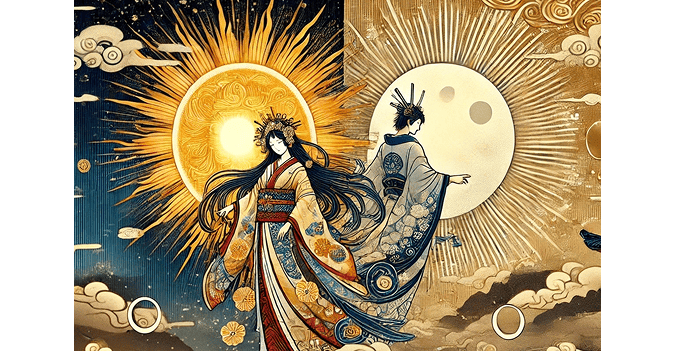
From that moment on, the Sun and the Moon were seen as forever separated. In the sky, of course, the Sun and Moon can sometimes appear together. But they do not truly share their light—when the Sun shines brightly, the Moon fades, and when the Moon glows at night, the Sun has set.
This story explained why day and night would never shine together in harmony.
A Reflection of Life
These stories remind us that sibling bonds are not only about harmony.
They can include moments of closeness as well as moments of conflict.
But they also offered ancient people a way to understand the world around them:
- why storms and disorder arise,
- why day and night are divided,
- and why even the gods experience conflict and reconciliation.
Through these tales, the Three Noble Children were not only divine rulers, but also reflections of human emotions—love, anger, pride, and forgiveness.
At the same time, they carried lessons about the order of nature and the teachings it offered to people’s lives.
Symbolism – Sun, Moon, and Sea in Japanese Culture
The myths of the Three Noble Children were not just old tales or legends.
They expressed how the people of ancient Japan looked at the world around them, how they felt about the gifts of nature, and the spirit with which they lived in harmony with those forces.
The stories reveal a unique worldview shaped by gratitude and respect for nature. Let us now look at each of the three deities to see the hopes and meanings that ancient people placed in them.

1. The Sun in Worship and Rituals
The Sun, linked to Amaterasu, became central in Shinto worship. Ancient rulers traced their lineage to the Sun Goddess, showing how political power was connected to divine light.
For ordinary people, the Sun was also the giver of harvests. Rice farming, the foundation of Japan’s early society, depended on its warmth and light.
To honor Amaterasu was to give thanks not only for divine protection, but also for the life-giving crops that sustained communities.
2. The Moon as Timekeeper
The Moon, tied to Tsukuyomi, shaped the way people measured time. The lunar calendar guided farming, seasonal festivals, and religious ceremonies.
But the Moon was more than a calendar. In the deep darkness after sunset, its glow was a precious source of light.
For the people of ancient Japan, the Moon softened the night, bringing both comfort and mystery.
Even today, traditions like tsukimi (moon-viewing) show the cultural memory of the Moon as a marker of beauty, rhythm, and celebration.
3. The Sea in an Island Nation
For the people of ancient Japan, the Sea was full of meaning.
It gave richness to life through fish, shellfish, and sea plants, and it opened paths for trade and exchange.
Yet the same Sea could also bring fear. Storms, waves, and tides sometimes destroyed boats, villages, and even crops. This mix of gratitude and awe was expressed through the god Susanoo, who embodied the wild and unpredictable power of the ocean.
At the same time, people believed that beyond the horizon lay the realm of the gods or the land of their ancestors. The Sea was not only useful and dangerous—it was also mysterious and sacred.
Taken together, the myths of the Three Noble Children show how the people of ancient Japan truly understood the greatness and importance of nature, and how they sought to live in harmony with it.
They did not simply expect blessings as something guaranteed. Instead, they approached nature with gratitude for its gifts and respect for its sacredness. At the same time, they accepted its fearful side—storms, darkness, and danger—as part of the world itself.
Through this balance of awe and thanks, ancient people found a way to live with nature as it truly was.
Parallels in Other Cultures
Stories of the Three Noble Children may sound unique to Japan, but the idea of using gods—or even divine siblings—to explain the order of the world is something many cultures share.
Perhaps there are similar stories in the myths and legends of your own country as well. People everywhere tried to explain the powers of nature by giving it shape through stories of gods and families.
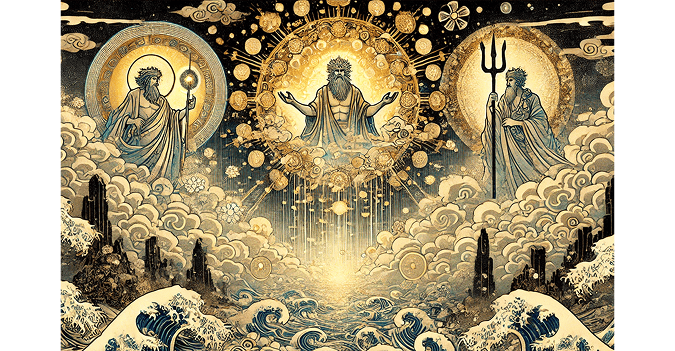
Here are a few examples from other traditions:
- Greek mythology: the brothers Zeus, Poseidon, and Hades divided the sky, the sea, and the underworld.
- Norse mythology: Odin and his brothers shaped the world from the body of a giant, setting realms and natural forces in place.
These parallels show that myths were not just entertainment. They were a way for people across the world to give meaning to life and place themselves within a larger order of the universe—just like in Japan.
Legacy – The Three Noble Children Today
What are the Three Noble Children to us now? Are they only figures from an ancient story, or part of distant history?
In fact, they are still present in Japan today. You can meet them in shrines, festivals, and traditions that have carried their spirit for centuries. Let’s look at where each of these deities is still honored.
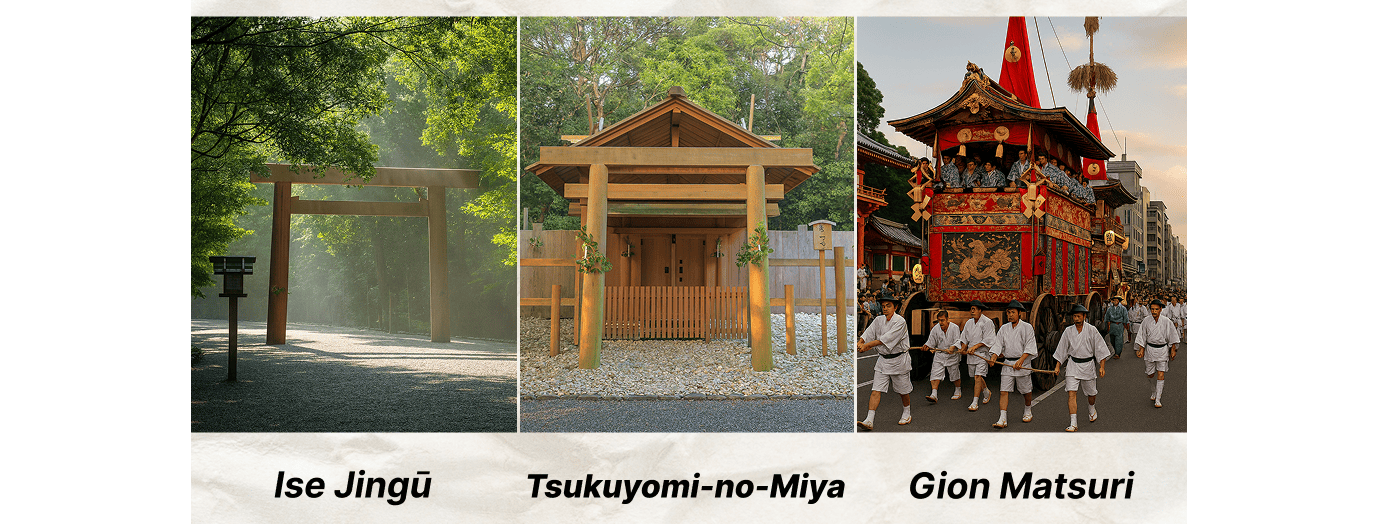
- Amaterasu is honored at many shrines, the most famous being Ise Jingū, the spiritual center of Shinto and the place where Japan’s emperors trace their divine connection.
- Tsukuyomi is remembered in smaller shrines, such as Tsukuyomi-no-Miya in Ise, and his role as the Moon God is still reflected in seasonal rituals and festivals that follow the lunar calendar.
- Susanoo is celebrated at shrines throughout the country, including Yasaka Shrine in Kyoto, known for hosting the vibrant Gion Matsuri, one of Japan’s most famous festivals.
For visitors, these places are not only religious sites but also cultural treasures where myth and tradition come alive. They are part of a living culture, still shaping how people in Japan celebrate the Sun, the Moon, and the Sea.
By experiencing these traditions, we too can feel the echoes of a story that has been told for more than a thousand years— a story that still shines in Japan today.
Conclusion – A Legacy That Still Shines
From a single moment of creation, the Three Noble Children came to embody the Sun, the Moon, and the Sea—forces that shaped the rhythms of life in ancient Japan. Their stories explained the cycles of nature, the struggles between harmony and conflict, and the deep respect people held for the world around them.
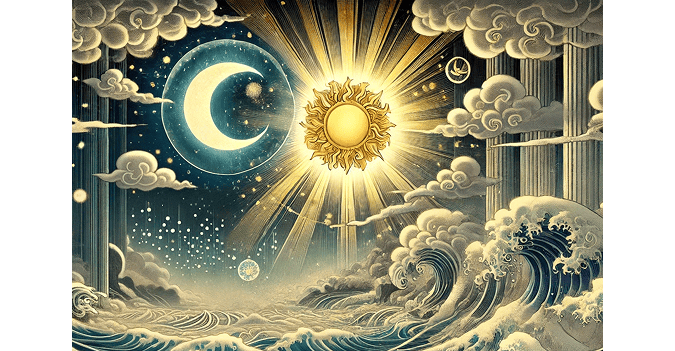
But these tales were never just about the distant past. Through shrines, festivals, and traditions, the legacy of Amaterasu, Tsukuyomi, and Susanoo still lives on today. They remind us that myths are not only about gods, but also about how people seek to understand nature, find balance, and give meaning to life.
As long as the Sun shines, the Moon glows, and the Sea moves with its tides, the voices of the Three Noble Children will continue to echo— a story of light, family, and nature that still shines in Japan today.